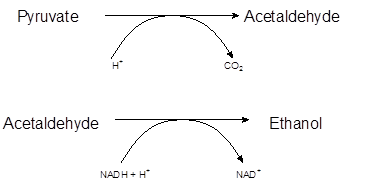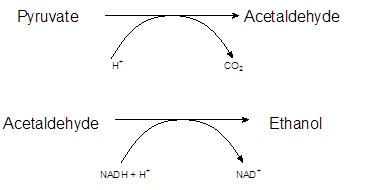
Concept explainers
(a)
Interpretation:
The role of coenzymes NAD+ and NADH in the conversion of pyruvate to acetyl CoA should be determined.
Concept Introduction:
Aerobic respiration occurs in two steps:
- Glycolysis
- Citric acid cycle
Glycolysis is the first step that forms pyruvate as given below:
In the presence of oxygen means aerobic respiration, this pyruvate enters the Krebs cycle and extracts energy in the form of electrons transfer. Electrons are transferred from the pyruvate to the receptors like
Answer to Problem 32P

Explanation of Solution
The
The overall reaction of glycolysis must be written as:
The pyruvate from glycolysis synthesizes acetyl CoA by the loss of one C atom in the form of CO2 gas in the presence of CoenzymeA. This breakdown of pyruvate molecule occurs by transfer of electrons to NAD+ to form NADH. Further, NADH will be used by the cell to produce ATP.

(b)
Interpretation:
The role of coenzymes NAD+ and NADH in the conversion of pyruvate to lactate should be determined.
Concept Introduction:
Aerobic respiration occurs in two steps:
- Glycolysis
- Citric acid cycle
Glycolysis is the first step that forms pyruvate as given below:
In the presence of oxygen means aerobic respiration, this pyruvate enters the Krebs cycle and extracts energy in the form of electrons transfer. Electrons are transferred from the pyruvate to the receptors like
Answer to Problem 32P

Explanation of Solution
The metabolism of glucose starts from the glycolysis process. It is the first step in cellular metabolism to extract energy from glucose. It is the sequence of 10 enzyme-catalyzed reactions that involve the glucose molecules into pyruvate with the production of ATP molecules.
The overall reaction of glycolysis must be written as:
The conversion of pyruvate to lactate is an enzymatical process. It is a hydrogenation reaction in which NADH changes to NAD+whereas the reversible process is catalyzed by lactate dehydrogenases.

(c)
Interpretation:
The role of coenzymes NAD+ and NADH in the conversion of pyruvate to ethanol should be determined.
Concept Introduction:
Aerobic respiration occurs in two steps:
- Glycolysis
- Citric acid cycle
Glycolysis is the first step that forms pyruvate as given below:
In the presence of oxygen means aerobic respiration, this pyruvate enters the Krebs cycle and extracts energy in the form of electrons transfer. Electrons are transferred from the pyruvate to the receptors like
Answer to Problem 32P

Explanation of Solution
The metabolism of glucose starts from the glycolysis process. It is the first step in cellular metabolism to extract energy from glucose. It is the sequence of 10 enzyme-catalyzed reactions which involves the conversion of glucose molecules into pyruvate with production of ATP molecules.
The overall reaction of glycolysis must be written as:
In the anaerobic conditions and presence of yeast, pyruvate converts to carbon dioxide and ethanol. Enzyme pyruvate decarboxylase catalyzes this reaction and removes a carbon dioxide molecule from the pyruvate to yield acetaldehyde which further changes to ethanol in the presence of NADH.

Want to see more full solutions like this?
Chapter 24 Solutions
General, Organic, and Biological Chemistry - 4th edition
- Indicate the products of the reaction between CH3COCH2COONa (Sodium acetoacetate) and BrCH2COOC2H5arrow_forwardIndicate whether the product of the reaction between Naphthalene and CrO3 in acetic acid at 25ºC is 1,4 naphthoquinone or phthalic anhydride.arrow_forwardIndicate the products of the reaction between CH3COCH2COOC2H5 and Na+-OC2H5.arrow_forward
- Primary, Secondary, and Tertiary Alcohols O-H O-H O-H R₁-C-H R₁-C-H R₁-C-R₁ H R₂ R₂ Primary Alcohol Secondary Alcohol ChemistryLearner.com R stands for Carbon group like ethyl methyl propyl Tertiary Alcohol If 1 carbon group with two H attached to alcoholic carbon, then primary If 2 carbon group and 1 H are attached to alcoholic carbon, then secondary IF 3 carbon group and no H attach to alcoholic carbon then tertiary. The bottom line Starting "Weak" oxidant material PCC, DMP, Swern, etc Primary alcohol Aldehyde OH Secondary alcohol Ketone OH "Strong" oxidant KMnO4, H₂CrO4 (or equivalent) OH Carboxylic acid 요 Ketone No reaction No reaction Tertiary alcohol 1. Is ethanol a primary, secondary, or tertiary alcohol? Write out the structures of ethanol and any oxidation products of ethanol. If there is more than one oxidation product, give the structure of each of the products. 2. Is 2-propanol a primary, secondary, or tertiary alcohol? Write out the structures of 2-propanol and any…arrow_forwardFormulate the reaction: Naphthalene with CrO3 in acetic acid at 25ºCarrow_forwardComplete the reaction hand written pleasearrow_forward
 Chemistry & Chemical ReactivityChemistryISBN:9781337399074Author:John C. Kotz, Paul M. Treichel, John Townsend, David TreichelPublisher:Cengage Learning
Chemistry & Chemical ReactivityChemistryISBN:9781337399074Author:John C. Kotz, Paul M. Treichel, John Townsend, David TreichelPublisher:Cengage Learning Chemistry & Chemical ReactivityChemistryISBN:9781133949640Author:John C. Kotz, Paul M. Treichel, John Townsend, David TreichelPublisher:Cengage Learning
Chemistry & Chemical ReactivityChemistryISBN:9781133949640Author:John C. Kotz, Paul M. Treichel, John Townsend, David TreichelPublisher:Cengage Learning Chemistry In FocusChemistryISBN:9781305084476Author:Tro, Nivaldo J., Neu, Don.Publisher:Cengage Learning
Chemistry In FocusChemistryISBN:9781305084476Author:Tro, Nivaldo J., Neu, Don.Publisher:Cengage Learning Chemistry for Today: General, Organic, and Bioche...ChemistryISBN:9781305960060Author:Spencer L. Seager, Michael R. Slabaugh, Maren S. HansenPublisher:Cengage Learning
Chemistry for Today: General, Organic, and Bioche...ChemistryISBN:9781305960060Author:Spencer L. Seager, Michael R. Slabaugh, Maren S. HansenPublisher:Cengage Learning General, Organic, and Biological ChemistryChemistryISBN:9781285853918Author:H. Stephen StokerPublisher:Cengage Learning
General, Organic, and Biological ChemistryChemistryISBN:9781285853918Author:H. Stephen StokerPublisher:Cengage Learning Organic And Biological ChemistryChemistryISBN:9781305081079Author:STOKER, H. Stephen (howard Stephen)Publisher:Cengage Learning,
Organic And Biological ChemistryChemistryISBN:9781305081079Author:STOKER, H. Stephen (howard Stephen)Publisher:Cengage Learning,





